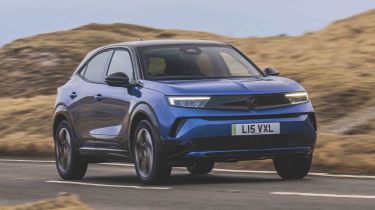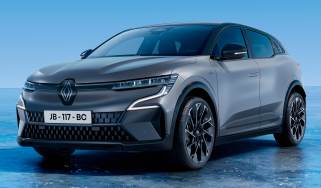Vauxhall Mokka - Engines, performance and drive
The Vauxhall Mokka impresses around town, but doesn’t offer much in the way of driver involvement

The previous-generation Mokka X was not a good car to drive, and while the second-generation Mokka still doesn’t offer as much driver involvement as the Ford Puma, it’s a more refined car than before.
There is still a choice of petrol and hybrid variants – each with around 130bhp. Our experience with the pre-facelift petrol car suggests the base engine will be perfectly adequate for most urban journeys, with the eight-speed automatic transmission, in particular, impressing us at lower speeds. It's easily a match for the dual-clutch automatic set-up of its Volkswagen Group rivals such as the Skoda Kamiq and SEAT Arona.
We’ve not driven either engine in the recently revised Mokka (only the EV), but we’ve tried them in a handful of the Vauxhall’s Stellantis siblings. The base version should feel sprightly enough, while the hybrid is moderately more efficient, claiming up to 57.8mpg on the combined cycle.
On the road, the latest Mokka doesn’t feel dramatically different. It’s still relatively grown up, and holds its own on most surfaces and road types. Run the car in its Normal mode and you’ll find it has enough power for ‘normal’ driving. Eco pegs things back and makes the Mokka feel quite lethargic, while Sport can feel a bit jerky in its responses.
Used - available now

2022 Vauxhall
Mokka
13,036 milesManualDiesel1.5L
Cash £16,900
2016 Vauxhall
Mokka
91,600 milesManualPetrol1.4L
Cash £4,500
2024 Vauxhall
Mokka
9,304 milesManualPetrol1.2L
Cash £16,887
2021 Vauxhall
Mokka
33,983 milesManualPetrol1.2L
Cash £15,087The Mokka Electric is much quieter than the petrol versions, and it’s extremely smooth when accelerating off the line. It doesn’t feel as rapid as some electric cars, but it’ll keep up with traffic well enough. You’ll need to engage Sport mode to exploit all its performance potential, because power is pegged in Normal and Eco driving modes in a bid to preserve electric range.
The easily accessible ‘B’ mode on the gearlever ramps up the regenerative braking, and while it won’t bring the car to a complete stop, it’s strong enough to reduce dependence on the left pedal in town. Turn it off on faster roads, and it’ll still feed energy back into the battery when coasting, albeit with significantly less aggression.
Overall, a Ford Puma is more fun, and a Skoda Kamiq is probably more comfortable. But the Vauxhall is the kind of car you can just hop in and drive, without much in the way of drama or surprise.
| Model | Power | 0-62mph | Top speed |
| Mokka 1.2 Turbo 136PS manual | 134bhp | 8.9s | 129mph |
| Mokka 1.2 Turbo 130PS auto | 128bhp | 8.9s | 126mph |
| Mokka Hybrid 1.2 136Ps e-DCT6 | 134bhp | 8.2s | 129mph |
| Mokka Electric 54kWh 156PS | 154bhp | 9.0s | 93mph |
What is the Vauxhall Mokka like to drive?
In town
We found the Mokka rides best at low speeds around town, where its CMP chassis (shared with Peugeot and Citroen) deals with the worst elements of scarred UK tarmac quite well. The suspension set-up can struggle to remain composed at higher speeds, but overall, the balance will be fine for most drivers.
On A- and B-roads
If you start to flex your right foot and push on, you’ll notice the unmistakable growl of the three-cylinder engine. Don’t be fooled into thinking any extra noise will yield an equal increase in performance – the Mokka is not a particularly quick car. Vauxhall has tried its best to accentuate the positive by offering a Sport driving mode, but it doesn’t make any meaningful benefits to the driving experience.
The EV doesn’t feel dramatically different, but the smooth power delivery and instant torque feels punchy enough out of tight corners. The weight penalty isn’t significant enough to have much bearing on the driving experience, either.
On the motorway
The motorway is the only place where the Mokka feels a little out of its depth. None of the engines feel particularly well suited to long motorway journeys, even if refinement is acceptable. The EV’s 154bhp electric motor gets off the line just fine, but lacks that instant shove on the move at higher speeds when the traffic in front clears and you want to accelerate, say, from 50-70mph. Range will take a hit if you sit at the national speed limit for long periods.
0-62mph acceleration and top speed
The entry 99bhp 1.2-litre petrol version in the pre-facelift Mokka has now been discontinued, leaving the base engine as a more potent 128bhp 1.2-litre petrol. It slashes the 0-62mph sprint from 10.6 seconds to 8.9 seconds. The 136bhp Hybrid is slightly faster (8.2 seconds) thanks to its added electrical assistance.
The outgoing Mokka Electric (formerly the Mokka-e) had an electric motor producing 134bhp and 260Nm of torque, and managed 0-62mph in 9.2 seconds. However, the latest version produces 154bhp from its single electric motor, which should allow for a 0-62mph in nine seconds flat. Both versions of the electric Mokka have the same electronically limited top speed of 93mph.







